When you’re considering a water filter or treatment system for your home, you’ll need to decide where you want it installed. Do you want to provide filtered water for your whole house? Or are you simply looking for a unit that will filter your drinking water?
If you’re after a filter that can provide you with the most all-round benefits for the water used throughout your home including your pipes, faucets, fixtures, showers, and appliances, a point of entry water filter is for you.
Table of Contents
🚰 What is a Point of Entry (POE) Water Filter?
Point of entry water filters are otherwise known as whole house water filters. They’re so-named because they’re installed at your home’s point of entry – i.e. the closest point to where your main water line enters your home. Usually, your main water line is on the perimeter of your house, street-side. It may also be in your basement or looped in the garage.
Because of its location, a point of entry water filtration system provides a complete filtered water solution for every tap in your whole home. The best whole house water filter for your situation will depend on the contaminants present in your water.

📰 Types of POE Water Treatment Systems
Whole House Water Filters
Whole house water filters are either media-based or cartridge-based. These filter systems use their own unique filtration process to filter contaminants out of water. This typically involves several different stages of filtration, including carbon filtration.
Some whole house water filters provide a complete solution for contaminant removal, while others target a specific set of contaminants. The most common water contaminants removed by a whole house water filter are:
- Chlorine and chloramine
- Pesticides and herbicides
- Heavy metals like lead
- Pharmaceuticals and other emerging contaminants
Maintenance for a whole house water filter depends on the type of system you own. Cartridge filters typically need twice-yearly filter replacements, while media-based filters last for up to 6-8 years before replacement media is needed.
Sediment Filters
Sediment point-of-entry water filters remove sediment from the entry point of your home, protecting your appliances and plumbing from abrasive particles.
There are several types of sediment filters, including spin-down sediment filters and cartridge filters. Spin-down filters have a longer lifespan because you can flush the filters periodically to remove built-up sediment.
Some of the common contaminants that can be removed by a sediment filter are:
- Dust
- Sand
- Dirt
- Rust (flecks of iron)
Most sediment filters have a lifespan of at least 6 months.
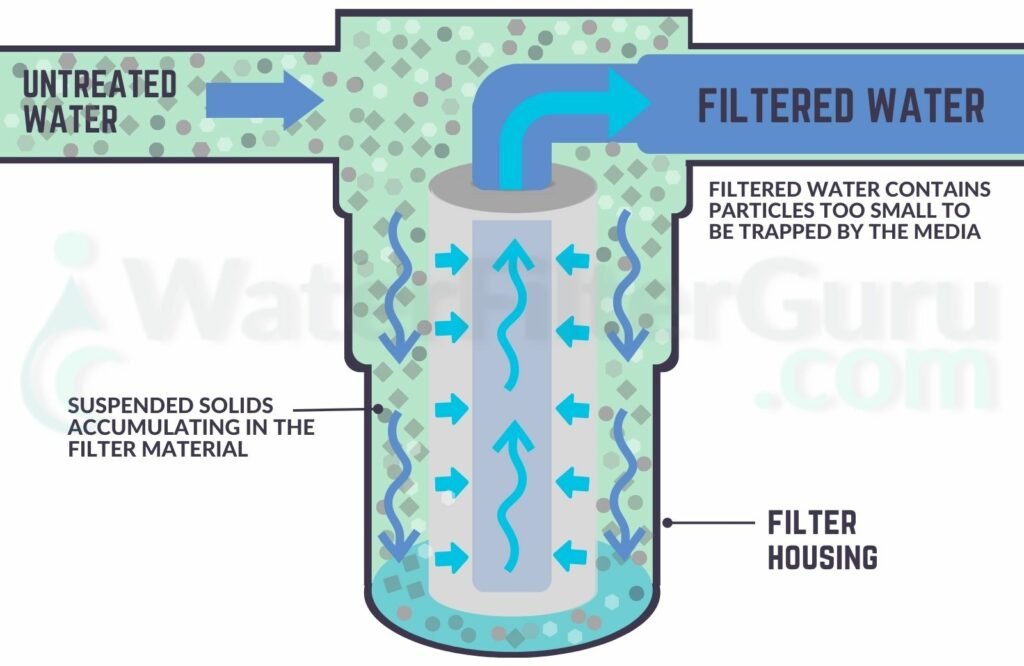
UV Purification Systems
UV purification systems are solely designed for water containing microbiological contaminants. UV purifiers don’t actually remove these contaminants from water – instead, they kill the pathogens and prevent them from being able to reproduce, making them harmless.
A UV purification system consists of a sleeve containing a UV lamp. The lamp emits ultraviolet rays that kill bacteria, viruses and protozoans in water as it flows through the pipes into your home.
UV purification systems can remove:
- Bacteria
- Viruses
- Cysts
- Fungi
- Protozoans
The average lifespan of a UV purification system is 1 year. After this, you’ll need to replace the lamp with a new one.
Whole House RO Systems
Reverse osmosis filters are typically installed as point-of-use applications, but point-of-entry RO systems are becoming increasingly popular. Reverse osmosis removes a broad range of contaminants, producing the purest water possible, making it a good choice for people looking for guaranteed protection against harmful contaminants.
To produce the highest-quality water, reverse osmosis sends water through several filter stages, including a carbon filter, and a semi-permeable membrane, which removes more than 99.99% of total dissolved solids (TDS).
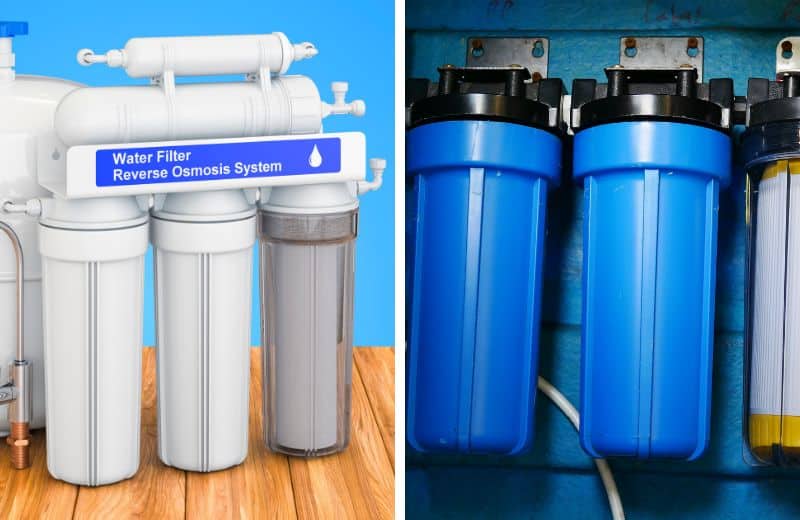
Some of the many contaminants removed by reverse osmosis are:
- Chemicals like chlorine, chloramine, pesticides, and herbicides
- Heavy metals like lead and arsenic
- Volatile organic compounds
- Emerging contaminants like pharmaceuticals
- Pathogens like bacteria
- Minerals and salts
The different filter stages of RO systems have their own lifespans. Carbon and sediment filter stages need replacing every 6-9 months, while the RO membrane has a 24-month lifespan.
Water Softening Systems
Water softeners don’t technically filter your water. Instead, these units prevent hardness minerals – calcium and magnesium – from causing scale.
There are two common types of water softening systems: salt-based softeners and saltless conditioners. Salt-based softeners use ion exchange to physically remove hardness minerals, while saltless conditioners crystallize the minerals and prevent them from forming scale.
The impurities tackled by a water softening system are:
- Calcium
- Magnesium
- Low levels of iron
Salt-based softeners require frequent salt top-ups, while saltless conditioners are more cost-effective, requiring only media changes once every 6-10 years.
Well Water Filter Systems
Well water filter systems use dedicated filtration technology to remove common well water contaminants.
There are several types of well water filters, including cartridge-based filters and tank-based filters. Some well water filters use focused treatment, like air injection/oxidation, to remove a handful of specific problem contaminants.
Some of the contaminants that can be removed by well water filters include:
- Flouride
- Arsenic
- VOCs
- Iron
- Manganese
- Radon
- Pathogens like bacteria
- Sulfur
The lifespan of a well water filter varies greatly depending on the design of the filter. Cartridge filtration systems need filter replacements every 6-12 months, while media-based systems require a media replacement after 8 years or so.
Find out what type of treatment system you need – take our quiz here!
✔️ What Are the Advantages of Point of Entry Whole House Water Filters?
Reduces Aesthetic Problems
Many point-of-use water filtration systems can remove or reduce the likes of sulfur, chlorine and iron. These ions are common culprits when it comes to aesthetic damage in your home – sulfur and chlorine can affect the smell and taste of your water, while iron can leave difficult-to-clean stains on your appliances.
A whole house water filter can filter out the contaminants causing your aesthetic problems, improving your water quality and reducing the need for frequent cleaning.
For those with a private well water source, a whole house water filter for well water will take care of iron and other nuisance impurities.
Extends the Lifespan of Appliances
When you install a point of entry system directly at your main water line, your entire home can benefit from better quality water from the moment it enters your home. The things that use water on a daily basis, such as your dishwasher, washing machine and shower, should last longer when they’re using clean, filtered water that won’t corrode or damage their surfaces.
Improves Drinking Water Taste
While it’s certainly an added bonus that a point of entry water filter can provide water treatment for your whole home, it’s probably a priority to you that your drinking water quality from your sink faucet is noticeably better.
A point-of-use water filter can improve your water’s taste and get rid of any unpleasant smells and odors. Some water filtration systems can also remove potentially harmful contaminants making water safe to drink, while the best whole house water filtration and softener system combos provide the best of both worlds, both filtering and softening water.
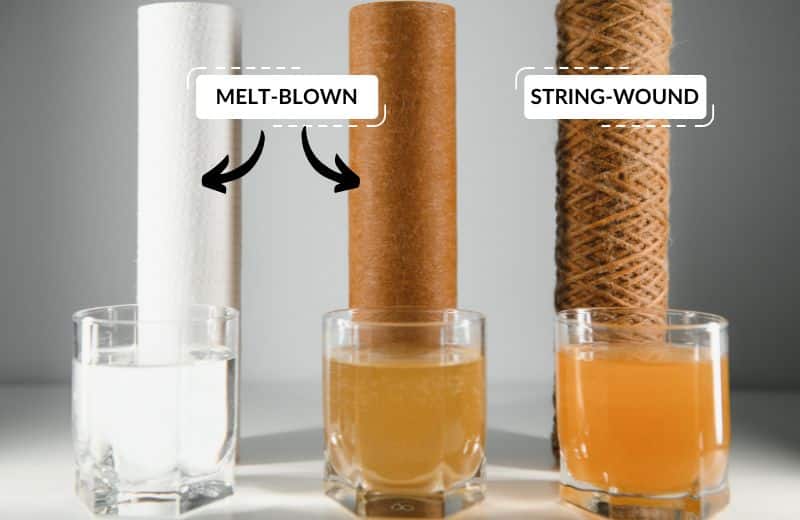
Saves Money on Bottled Water
You won’t need to buy bottled water when you have a point-of-use water treatment system. You’ll get the same great-tasting high-quality water as you would from bottled mineral water – and it’ll come straight from your faucet for your convenience.
If you’re not sure how much money you’ll save by cutting single-use plastic bottles out of your life, work out how much you currently spend on water bottles per month, then multiply it by 12.
That’ll give you an estimate of how much you currently spend per year. Trust me – the up-front cost of any point of entry system will be much cheaper than the accumulated cost of bottled mineral water.
Reduces Hair and Skin Problems
A whole-home water softener, a popular point of entry water treatment system, can be particularly helpful in eliminating minerals like calcium and magnesium. These minerals have been linked to skin irritation and dryness, as well as dandruff, itchy scalp and hair breakage.
When you install a point-of-use water softener, you should see a noticeable improvement in your hair and skin health, if this has been a problem for you in the past.
High Capacity
Standard whole-home filter systems can provide gallons and gallons of clean, filtered, sediment-free water – there’s no limit to how much they can produce.
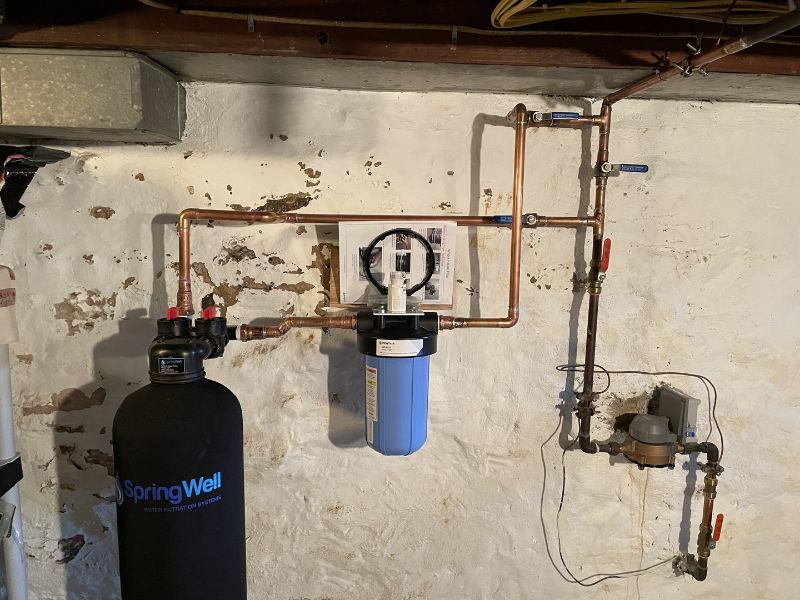
❌ What Are the Disadvantages of Point of Entry Systems?
Difficult to Install
Because they’re installed at your main water pipe, point of entry water filtration systems aren’t always easy to install.
The exact complexity of a system installation depends on what type of filtration system you opt for, but either way, you’ll be required to cut through your point of entry water line and make a connection to install the system. If you don’t consider yourself very handy, you may not feel confident in installing a point of entry water system – which may mean you have to pay for a plumber or handyman to do the job for you.
Some Systems Require Frequent Maintenance
Some point of entry water filtration systems require more maintenance than others.
Reverse osmosis systems, for instance, are highly effective – but require extensive maintenance and the reverse osmosis membrane needs replacement on average every 2 years.
Salt-based softening water systems require regular salt top-ups, too, and complete media replenishment every 6 years or so.
Even the best UV purification systems require lamp replacements every year or so.
If you’re looking for a whole home water treatment system that requires limited maintenance, you’re best narrowing your search to look specifically at whole home filters or conditioners with a resin or media bed, as you’ll commonly only need to replace these once every 8 to 10 years.
Can Be Expensive
Again, some point of entry water systems can cost more than others depending on what they can offer. You’re likely to spend more on a reverse osmosis system, which offers the highest quality of drinking water treatment, combining a carbon filter with a sediment filter and 0.001-micron RO membrane to provide a solution for removing chlorine, VOCs, lead, arsenic, harmful bacteria, fluoride, and so on.
If you’re looking for a point of entry system that can reduce or remove a specific water contaminant, such as iron, hardness, chlorine, or lead, you may be able to pay slightly less – but you’re still looking at around $400-$500 minimum for a decent system.
📝 When Should I Use a POE Water Filter?
There are several reasons why you might feel it’s necessary to use point of entry water filter systems instead of point-of-use filters.
Usually, you’ll consider this option when you’re keen to improve the quality of the water in every tap and different type of water-based appliance in the home you live in, rather than simply improving your drinking water quality.
You might want a point of entry water treatment system if:
- You’re looking for a way to improve the performance of your appliances and save money.
- You’d rather be showering, washing or bathing in water that smells fresh and runs clear.
- You don’t want to breathe in harmful chemicals when you shower.
- You’re keen to save time on your water-related cleaning tasks around your home.
- You want to save money and the environment by reducing single-use water bottles.
- You want to find an easy solution to tackle staining on your laundry and kitchenware.
- You own a private well and need to treat problem contaminants.
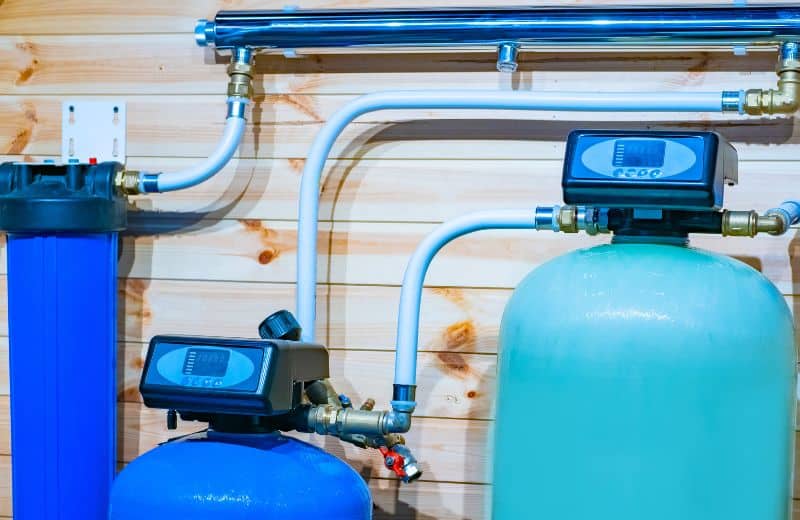
💬 FAQs
What are the differences between whole-house filtered water treatment vs point of use filters? Which is best?
It depends on what your household needs. The problem with the more portable, no-installation point of use water filters is they tend to have a limited capacity and can only produce batches of water of several gallons at a time, which isn’t ideal for larger families.
Additionally, there are some types of point of entry filter, like water softeners, which are only available as larger, whole-house products, so you couldn’t get them as a point of use product.
However, comparing point of use water filters vs point of entry water filters, these two different product types typically have the same features and can address the same concerns (this includes chlorine, heavy metals, bacteria, and so on). The only real difference is related to size and price – you’ll find some more affordable options when looking at portable filtration systems.
Are whole home filter products worth their value?
Again, it depends on which product you choose, but with the majority of high-quality products, yes. The money you’ll save on bottled mineral water, additional water use in inefficient kitchen and bathroom appliances, and cleaning tools to eradicate hard water scale and mineral staining, should mean that your system pays for itself in a matter of years. Plus, you get to directly protect your family with a system that’s designed to produce better-tasting, odor-free treated water, so it’s a win-win all round.
